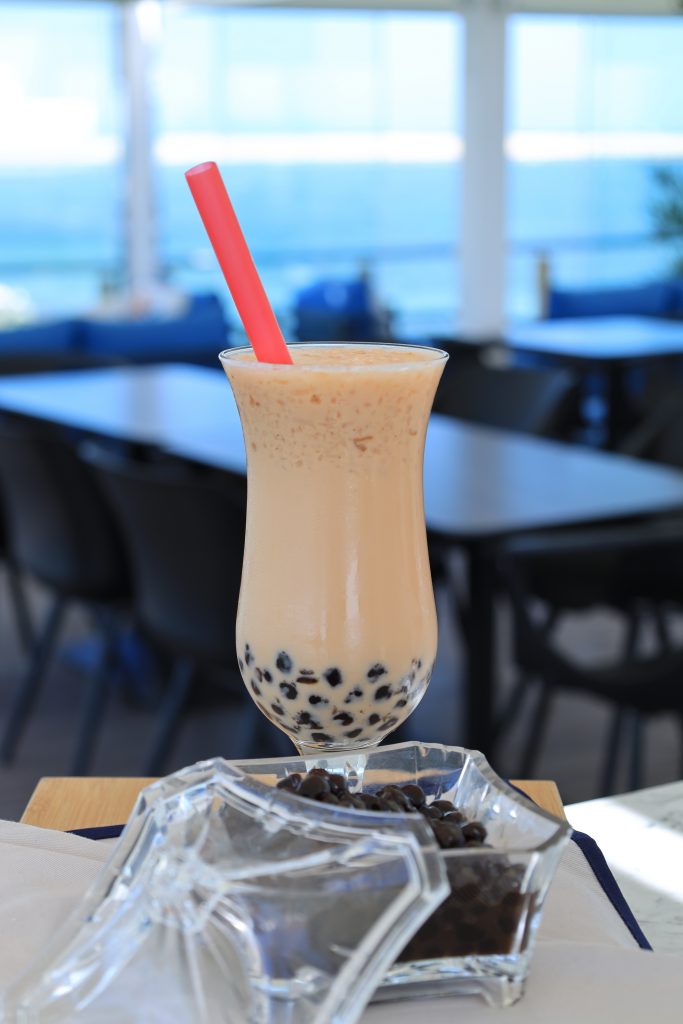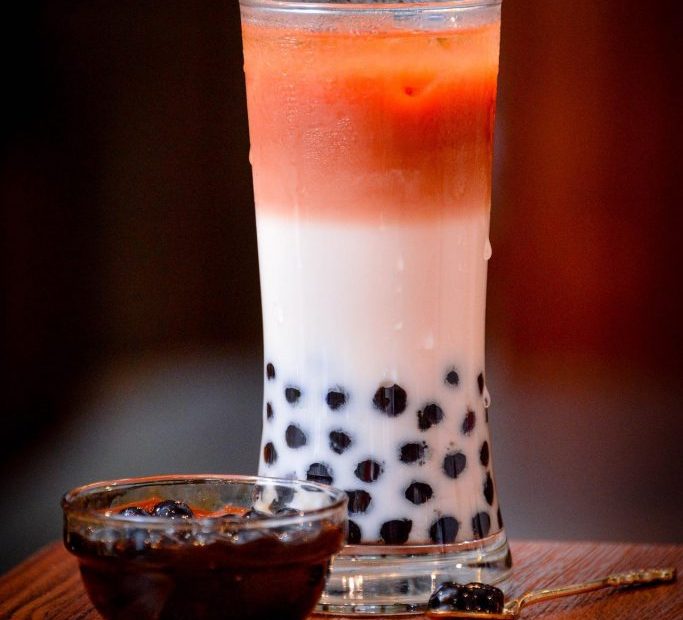Bubble Tea: What It Is And How To Prepare It
You have surely met people on the street intent on sipping from over-size glasses, a strange colored drink with many strange balls deposited at the bottom.
They were drinking a Bubble Tea, one of the beverages that are becoming increasingly popular around the world.
Want to find out more about it? In this blog post, we explain what it is and how you can prepare it at home.
What Is Bubble Tea?
Bubble tea is a drink, both hot and cold, also known by the names Pearl Milk Tea, Boba Milk Tea or Boba Juice. In Taiwan, the most commonly used name is 珍珠奶茶 Zhēnzhūnǎichá (Pearl Milk Tea).
The beverage was created in Taiwan in the 1980s. The name is intriguing, as everyone is aware that the phrase “bubble” refers to a type of chewing gum used to inflate balloons. So what is the connection to tea? Soon it was revealed that black tea, milk, and tapioca pearls—which have a gelatinous consistency and a flavor somewhat resembling licorice—were the main ingredients in the original bubble tea. Since tapioca is gluten-free, it is also safe for people who have celiac disease. Since its inception, several variations have been added, but the fundamental principle has remained the same: bubble tea is consumed while also being chewed.
Origins
The origins of this quirky drink sink in Taiwan in the 1980s. The term “Bubble” has a dual meaning: it recalls the bubbles you make with chewing gum, but it also has a connection to the term “Boba,” a Taiwanese word for tapioca pearls.
It was originally designed as an after-work drink to refresh and refresh after a long, heavy day.
Ingredients
The basic ingredients are:
- black, Wulong or green tea
- milk and/or fruit
- sweetener
- tapioca (boba) pearls or fruit jelly pearls.
Each ingredient can be used in any of its variations. We will talk about this in a moment. The beauty of Bubble Tea lies precisely in this, in its versatility of preparation that gives different and colourful results every time! For example, instead of tea, coffee can be used or even in Hong Kong the coffee and tea together variant was created.
Tea
Any kind of tea can be used. From classic black tea to matcha. Regardless, the best types are those that have a robust flavour, such as black or jasmine tea. In fact, its taste should be felt even after the addition of milk and ice. Oolong tea is also often used.
Tapioca Pearls
Tapioca pearls are the product obtained by processing tapioca, a special starch derived from cassava, a shrub native to South America, also known as Yucca or Cassava. Tapioca pearls, raw are transparent, while after cooking they become darker.
Their use in Bubble Tea involves boiling, in fact they are almost black and very soft.
They do not have a particularly strong flavor, but they need something to give them a little taste and sweetness. They are therefore left soaked in food syrups and toppings (in a variety of flavors and colors!) until the Bubble tea is prepared. At this point the pearls are placed in the bottom of the glass that will contain the drink. The function of the pearls, then, is not to flavor the drink, but to add texture and a very unique look!
Tapioca is gluten-free, so green light to the fashionable drink even for those with celiac disease.
You can find them in Asian food stores or online such as on Amazon.
As an alternative to tapioca you can use fruit-flavored gelatin pearls, the important thing is that there are bubbles otherwise it would no longer be a Bubble Tea.
Milk
The best milk for making Bubble Tea is whole or semi-skimmed milk. As with tea, variations such as vegetable milks can be used for milk. The important thing is that it is a medium-fat milk so that it can add texture and creaminess to the drink. Skim milk or vegetable milk that is too watery (e.g., rice or oat milk) does not give sufficient creaminess and the risk is of getting a tasteless Bubble Tea.
Among the various types of vegetable milk, coconut milk, almond milk, and soy milk are excellent.
Sweetener
It all depends on personal taste, both for the type of sweetener to be added and the amount you want to use: brown sugar, honey, agave syrup… If you use vegetable milk that has already been sweetened, you can also avoid sugar to save calories.
This premise applies to homemade Bubble Tea. Separate discussion-and a sore point-relates to Bubble Teas purchased from the now famous chains. The products that are served here are a riot of sugar. Not surprisingly, a 200 ml glass of an average classic type provides 300 to 500 calories!
How To Prepare It At Home
Home production in addition to being certainly cheaper allows you to decrease calories a lot.
Here is the recipe to be able to prepare it yourself at home:
Ingredients
60 g tapioca pearls
500 ml of water
Tea (in leaves or sachet depending on your habits)
100 ml milk (cow or vegetable depending on taste)
For the syrup
150 ml water
100 g of brown sugar
Addins
Pieces of fruit in syrup and fruit or coconut jelly, nectar or fruit juice
Procedure
Soak the tapioca pearls in water for 1 hour and in the meantime prepare the syrup: bring 150 ml water to a boil, dissolve the whole cane sugar in it, turn off the heat and let it cool. Add any toppings and pieces of fruit to taste.
Prepare the tea
Rinse the tapioca pearls from the soaking water and cook them for 5 minutes in boiling water. Rinse them in cold water after draining. All components should be combined in a shaker and shaken for a short while. Take a straw (made of paper) and savor your bubble tea!
Storage
This is a great recipe if consumed immediately.
Tastes
As far as flavors – and consequently colors – are concerned, one is spoiled for choice.
Classic Fruit
The most classic versions have fruity flavors.
- Apple
- Orange
- Lemon
- Plum
- Peach
- Strawberry
Exotic fruit
Still, on the fruit theme, there are also tropical flavors.
- Lychee
- Mango
- Passion fruit
- Avocado
- Ginger
Tasty flavors
There are also variations with decidedly yummy flavors that are impossible to resist.
- Almond
- Coffee
- Pudding (chocolate or custard)
- Barley
- Caramel
- Chocolate
Floral flavors
There are even versions with floral flavors.
- Lavender
- Rose
- Sesame
- Violet
Summer bubble tea
This is a drink that does not follow a seasonality. To make it more refreshing, a few ice cubes Calories added in summer.
Is the bubble tea healthy?
Without a sure, the experience must be had; nevertheless, keep in mind that there are plenty of calories. The most ardent critics claim that bubble teas contain excessive amounts of sugar and that those sold in institutions also contain excessive amounts of colors, preservatives, and chemicals. Generally speaking, a 200 ml glass contains 300 to 500 calories. There are, however, also zero-calorie variations that use chia seeds in place of tapioca and are sugar-free. We suggest matcha bubble tea for people who prefer a choice that maintains a decent nutritious level despite the absence of sugar. The tea with the highest amount of antioxidants—even higher than green tea—matcha is abundant in vitamins, minerals, and polyphenols. It blends well with both organic and almond milk. Again, topping it are chia seeds.
Tips For Light Variants
If you are watching your figure, you don’t have to give up Bubble Tea. It is possible to make lighter versions. Let’s look at a few tricks to cut calories:
replace sugar syrup with agave or stevia syrups
use low-calorie milk, such as unsweetened soy milk
eliminate milk and instead use coconut water, which has only 19 calories
replace tapioca pearls with chia seeds
Trivia
Bubble Tea is drunk with special straws that are larger in diameter than regular straws because they must be able to absorb the tapioca balls as well.

